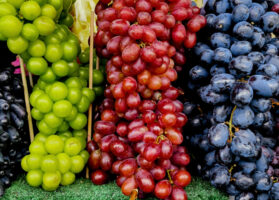Peru: Piura’s table grape production closing in on Ica
Overview of grapes from Peru in the U.S. market, complemented by charts from Agronometrics. Original published on February 1, 2023.
20 years ago, the northeast city of Piura embarked on the transformation of thousands of hectares of uncultivated land into agricultural exports, with table grapes being one of the main crops planted.
While other growing regions in Peru, such as Ica, were already a representative territory for this cultivar, Piura has slowly become a reputable table grape exporter, with over 30 million boxes shipped yearly, according to InfoMercado.

Source: USDA Market News via Agronometrics.
(Agronometrics users can view this chart with live updates here)
Among the producers of this agro-export offer is Sociedad Agrícola Rapel, a Chilean capital company with 35 years of experience in the production of fresh fruit.
Pablo Eyheralde, Rapel’s general manager, told InfoMercado that of the 4,000 hectares owned by the company, 3,000 are highly productive for fruits such as table grapes, blueberries and Tahiti lime.
Of this total land, 80% is dedicated to planting and harvesting table grapes, both Red Globe and Seedless. The remaining percentage is devoted to blueberries and lemons.
The growth of this production would not have been possible without the investment of this company. According to Eyheralde, in more than 10 years of work in Piura, the investment figure exceeds US$300 million.
Fruits for export
On average, Rapel exports 4,500 containers of fruit each year. Its main export product are table grapes, 65% of which are seedless, and 35% are Red Globe.According to Eyheralde, Piura’s total production of table grapes narrowly exceeds that of Ica.
“We exceed Ica by very little. Some 30 to 35 million boxes of table grapes are exported from Piura per year. Peru exports 70 million boxes,” says Rapel’s manager.
In the Piura region, table grape production starts in the second half of September and ends at the end of December. In the south, it starts in the second half of November and ends on the last day of February.
As for blueberries, they are still a recent commercial bet. Eyheralde states that they started the production of this fruit because the lands of Piura are warm, and the climate and water are suitable for this crop. At the moment, Rapel produces 10 tons of blueberries per hectare.
“We still do not have large blueberry production, but results are good. Trujillo is producing the best blueberries in the country due to its climatic and soil conditions; and it has no contact with pests,” he said.
Regarding lemons, the executive assured that it is also a new bet of the company. Rapel does not produce Sutil lemons, which are very well known in the north, but the Tahiti type, a fruit without seed, larger in size, with more juice and less acidic. This variety is in great demand in markets in the U.S., Latin America and some European countries.
The News in Charts is a collection of stories from the industry complemented by charts from Agronometrics to help better tell their story.
Access the original article with this (Link)






